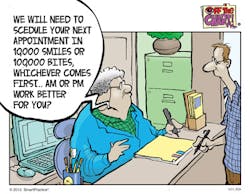Reader's Forum
Dear RDH:
Lynne Slim (in “Perio/Cardio Link Debunked,” July 2012) enumerated some of the limitations of scientific studies that report associations, but can’t meet the highest standards of evidence that point to causality. Unfortunately, Ms. Slim seems unaware that the American Heart Association’s (AHA) press release (that accompanied the AHA’s recent statement on periodontitis and ASVD) was immediately retracted because of factual errors. Indeed, the AHA press release impugned the reputations of many biomedical scientists by inaccurately stating that there had been no adjustments for confounders in the studies that showed associations between the periodontal diseases and atherosclerotic vascular diseases (ASVD). Also unfortunate, Ms. Slim overlooked what associative studies may mean clinically — especially when higher quality evidence is not available.
Truth exists independent of science. Scientific investigations are undertaken to reveal truth via evidence. Some evidence is deemed of higher quality because it is less prone to bias. For example, randomized controlled clinical trials are less prone to bias than are studies that “data dredge” existing databases in attempts to identify novel associations. In the context of the widely accepted evidence hierarchy, associative studies are ideally used primarily to identify putative causal links. Hence, some rightly term associative studies as “hand waver” investigations, insofar that they suggest that additional studies are needed.
After reviewing the existing biomedical literature, and noting the lack of high-level evidence to support a link between the periodontal diseases and ASVD, the AHA statement wisely recommended that additional research is needed. However, the AHA statement also engaged in hyperbole unsupported by data. Indeed, the abstract of the AHA statement decried what the authors deemed to be marketing excesses with regard to some of the suspected perio-systemic links. These were not discussed in the paper itself. Furthermore, nowhere in the statement were the authors’ notional costs of perio-systemic over-marketing compared with the potential costs associated with not alerting patients that plenty of evidence exists that links unhealthy periodontal circumstances with a greater severity or likelihood of life-changing ASVD-related events.
To compound this bias, the AHA statement went well beyond what would have been merely an unfounded recommendation against periodontal interventions and instead stated — based on no evidence or cost-benefit analyses whatsoever — that periodontal therapeutics based on links to ASVD are “unwarranted.”
Unfortunately, the AHA statement typifies what’s become fashionable in some circles, namely a bias toward dismissing interventions that are not backed by high-quality evidence. But because truth exists independent of evidence, and high-quality evidence may not always be available, the AHA’s mandate exhibits glaring bias toward non-intervention without any discussion or comparison of costs versus benefits. Astute RDH readers may recognize such a “no-treat-unless-sure” mindset is commonplace in the Canadian, British, French, German, and other socialized health-care systems that reduce costs by mandating that high-level supportive evidence be in place before certain treatments will be authorized. However, the AHA statement fails even in the context of cost control, insofar as the costs of improved oral hygiene are trivial compared with even minimal improvements in ASVD-related events.
The bottom line is that the dental community would be wise to ignore the AHA statement. Based on the existing evidence, it’s reasonable for dentists and dental hygienists to alert patients that there is science that suggests that better oral health may decrease the incidence or severity of ASVD-related maladies such as strokes and heart attacks. On the other hand, it seems unreasonable to overstate this science to support marketing gimmicks aimed at cajoling patients into therapy that they would otherwise not accept. These are carnival acts and ought to be dismissed by responsible clinicians.
For a more detailed critique of the AHA statement, see Rethman M: “The AHA scientific statement on periodontal disease and ASVD: How should clinicians respond?” Compend Contin Educ Dent 33:392-393, 2012.
Michael P. Rethman, DDS, MS
Honolulu, Hawaii
Past RDH Issues

